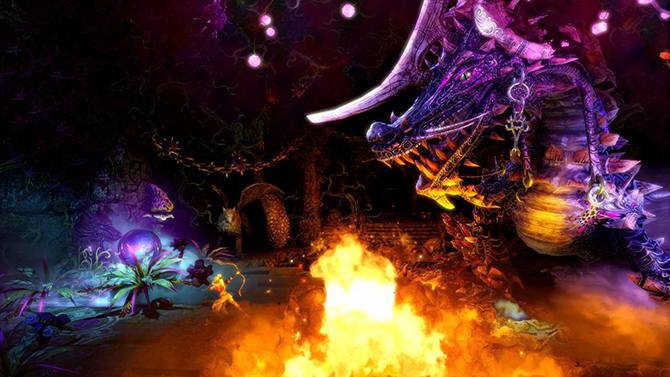Trine 2

Publisher: ATLUS / Developer: Frozenbyte, Inc. / Platform: PC, PSN, XBLA
Alright, so, the standard knight/rogue/mage trio has been beaten to hell in just about every RPG ever made. But, how would these three classes fair in a platformer? Trine 2, the sequel to 2009’s Trine, takes otherwise-commonplace RPG tropes and translates them into the platformer genre.
Now, I have never played the first Trine. I really knew nothing of what to expect with it’s sequel other than the fact that it is a physics-based puzzle/platformer. The first thing I noticed when starting the game was the breathtaking graphics. Everything was bright and colorful and looked like something out of a pop-up story book. The second thing I noticed, though, was that aside from voices and music, the game had no sound effects. Tinkering with the audio levels didn’t fix anything, but exiting back to the main menu and messing with the sound there seemed to fix it. I later realized, after many instances of starting the game with no sound, that for whatever reason if you select “New Game” or “Resume Game” too quickly after starting the game up, your game will start with the sound effects muted. Strange.
In Trine 2 you control three characters, each with their own abilities and equipment. The Wizard can summon blocks and planks to solve puzzles, the Rogue has a bow and a grappling hook, and the Knight can wield a sword and shield or a hammer. Each of these characters’ skills are needed to solve the many puzzles that await.
Along your travels you’ll collect little blue vials that act as experience points. Every 50 vials collected gives you one skill point to unlock a new ability for one of the three characters. These skills can range from allowing the Wizard to summon more than two blocks at a time to giving the Rogue the ability to freeze enemies. This seemed like a neat idea until I realized that many of the puzzles almost require a specific skill to be unlocked but do not give you any warning ahead of time that you will be needing it. For instance, the Knight can get a skill that allows him to do a running strike with his sword. Seeing as the combat in Trine 2 is far less challenging than the puzzles, I decided to skip unlocking it until towards the end of the game. Little did I know that this running attack actually helps the knight to jump further, which would have greatly reduced some frustration with some of the puzzles earlier in the game.

Speaking of frustration (I feel like I’m about to get burned at the stake for this), I found a large portion of Trine 2‘s platforming and puzzles to be a little on the unfair side of challenging. Maybe a large portion of them would be easier had I unlocked the Knight’s dash attack, but a few of the puzzles that had me really stumped, and even looking online for help (yeah yeah, I know) mostly yielded solutions that almost seemed like glitches. The game does offer a hint system that is supposed to kick in if you’re stuck at a puzzle, but for whatever reason I was never able to get that to trigger, no matter which option I had selected for the hint timer.
Did this ruin the entire game for me? Eh. When Trine 2 is good, its really good. Swinging around on the Rogue’s grappling hook is a lot of fun. The Knight is built like a tank and it really shows well in his combat. Aesthetically, as I’ve mentioned before, the game looks fantastic. The game just comes to a screeching halt from time to time when it hands you a puzzle that barely makes sense.
Perhaps I’m missing some big thing that makes Trine 2 much more enjoyable. You know what? I really hope I did. The entire game made me feel like I was missing some crucial gameplay mechanic that makes everything flow better. If I did, I’d be glad to play the game through again the way it was supposed to be played. Until then, however, Trine 2 just seems to me like a potentially fun game marred by bad puzzle design.

















